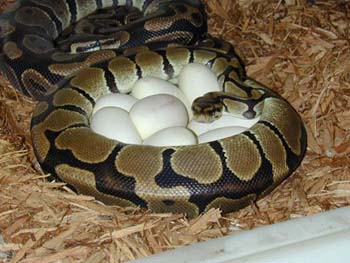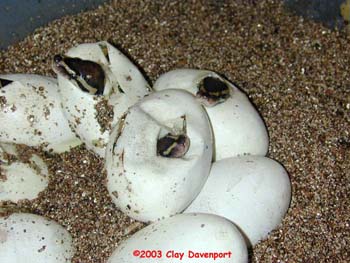What can be said of the ball python? This species is probably either the first or second most commonly kept snake species, with the cornsnake filling the other position.
Balls are found in the wild over large parts of central and west Africa. They are natives to the arid grasslands and savannahs.
Largely ignored, and regarded as too common to bother with for years, the ball python now enjoys a tremendous following.
This is almost entirely attributed to the development of the various morphs. In the early 90s Bob Clark started it all with the albinos, and the fever has spread like wildfire, with thousands flocking to get in on the action.
Whether you like the morph frenzy or not, it is here to stay, at least into the forseeable future. As far as I go, I was involved with it for 8 years or so but I just got burned out with it. I haven't really even kept up with what's been produced for the last several years. I like seeing the new morphs, and what's possible with the genetics, but at the same time it also pains me to see these snakes being reduced by many to just a commodity. This is not the place for my rantings however.
The morph market aside, balls are just great snakes to keep. They are extremely docile, undemanding captives, and remain at easily managable sizes. The are reluctant to bite, and easily handled. A good quality captive born ball that is an established feeder makes an excellent pet for any new snake owner.
Captive Care
Care is straightforward. An ambient temperature in the low to mid 80s with a basking spot of around 90. They don't have any special humidity needs, but raising it slightly during shedding is recommended.
A nice tight hide box is greatly appreciated by these snakes. I like to give them a decent amount of room for when they want to move around, but when hiding they prefer the security of a hide box they can just squeeze into. You want a box that doesn't have alot of height, and one they can touch the sides when coiled inside. They are fairly sedentary most of the time and may spend several days at a time in the security of their hide venturing out occasionally at night to explore the cage.
Balls are sometimes prone to fasting for no apparent reason. Some do it with some frequency, while others practically never skip a meal. This can be quite disconcerting to novice keepers. They seem to be well equipped for this lifestyle however, and are capable of undergoing such fasts while losing a minimum of weight.
I once had a large adult female decide one spring that she wasn't going to eat for a while, six months and three days to be exact. During this time, which encompassed the entire summer, she lost around 80 grams. Not bad for a 2500+ gram snake. Then one day she decided the fast was over and went back on feed as if nothing happened.
Normally a fasting period is nothing to be concerned with, if all other parameters are optimal such as health, temperature, etc. Of course it's more of a concern with hatchlings. You don't really want a little one going 6 months without food, but a few weeks isn't going to be detrimental.
Feed appropriately sized prey weekly. Adults can often be maintained on a bi-weekly schedule unless they are breeding females. Hatchlings start on weaned mice or rat pups, and adults do well on small adult rats.
This is also a long lived species when well cared for. The current longevity record is for a ball captured as a young adult and kept by the Philadelphia zoo for 47 years. It can easily be expected that you could have your ball for 20-30 years if you take good care of it. I have a female myself that I acquired as an adult 25 years ago.
A note on Acquiring a Ball
While it's a little more common today than in recent years, the captive reproduction of normal balls remains the exception rather than the norm, and when they are produced it is as a byproduct of morph production, hets or normal siblings to a codom mutation. Every year tens of thousands of baby balls are imported into this country from Africa, under the labels of "captive hatched" or "farm raised". What these labels mean is that a gravid female was caught in the wild and kept until she laid her eggs, after which she may have been released or herself sent into the pet trade. In my opinion this is just another version of wild caught. I simply cannot support this practice on the current scale, and encourage anyone interested in owning a ball to seek out a breeder and purchase a domestically bred hatchling.
True, the baby will likely cost a little more than a fresh import, but the breeders should be supported, and despite the claims of many importers, I still believe you will be getting a higher quality animal. In reality, while you can get an imported baby for $20 or often less, a domestically bred baby normally only runs $40-50 or so, and I consider that a very insignificant difference when you consider you can potentially enjoy this animal for the next two or three decades.
To be brutally honest, if you are one to balk over paying the small difference to get a truly captive born animal, then I for one don't particularly want to sell you one anyway, you don't deserve it.
If the buying public would forget about the paltry price difference and seek out breeders to purchase their baby balls from, then the practice of importing in the rediculous quantities seen today would begin to decline and more people would begin producing them.
These are wonderful snakes, and deserve more respect than a cheap trinket mass produced in China.






